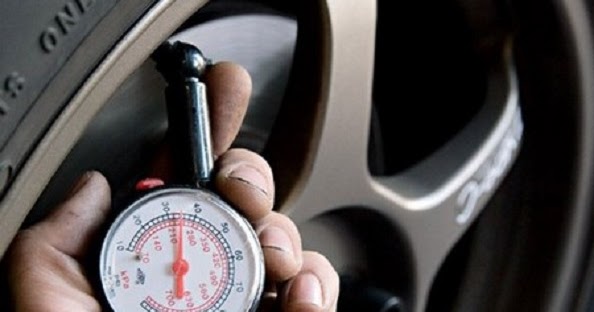Spare tires are not always included with the purchase of a brand new car, but their importance makes them a necessary addition to the essential on-road equipment. Because it’s seldom used, spare tires spend years beneath the carpeting of the trunk or attached to the vehicle’s undercarriage, slowly deflating over time. By the time you need it, it might already be deflated beyond the point of usability, defeating its purpose.
In this guide, I’ll teach you what the standard spare tire air pressure should be, and ways to refill it on the road. So stick around and learn a few useful tricks that will certainly pay off at some point!
Space saver spare tires have to be filled with much more air than standard, full-sized tires. The smaller dimensions, especially the contact surface are the reason why spare tires need more air. The best way to find the exact pressure needed for your spare tire is to check the markings on it. If you have never used it, you’ll find a piece of paper with useful information attached to the tire.
Alternatively, you can take the dimensions of the tire and search for appropriate tire pressure. You don’t need the entire specification, just the three dimensions. Here’s an example of what it looks like: 225/70 R 16.
The first, triple-digit number tells you the width of the tire while the second is for the aspect ratio. The letter R is for radial construction, which is the widespread standard, while the last two-digit number tells you the rim diameter. They’re followed by an additional load index, which is important for full-sized tires, but not as much for spare tires.
Another way of figuring out tire pressure is to open the driver’s door and look at the plate located on the B-column (column between driver and rear passenger door). This plate can also be found on the inside of the gas cap. It illustrates different use scenarios and tire pressures you should use. Spare tire information isn’t always there, but it’s worth check as it only takes a second.
It illustrates different use scenarios and tire pressures you should use. Spare tire information isn’t always there, but it’s worth check as it only takes a second.
In general, space saver tires are pressurized to 60 PSI or 4 BAR. This might seem like a lot, but as previously explained, smaller tires need higher pressure to keep up with the weight. To put it in perspective, the slim tires used on professional bicycles can go as high as 130 PSI! If you were to pressurize a space-saver to the levels used by full-sized tires, you’d risk wheel damage
Full-sized spare tires are typically included with trucks, SUVs, and other heavier vehicles as they need to endure the extra load. If your vehicle didn’t come with a spare tire, and you’ve got room in the trunk to spare, buying a steel-rimmed wheel and an extra tire is a great way to solve the problem. If you happen to have two sets of wheels for different seasons, it’s completely okay to use a tire from an alternating set as a backup.
There’s a distinction between a full-sized spare and a regular tire used as a spare. the actual full-sized spare tire has the right diameter but is not as wide as other tires. It requires somewhere between 30 and 60 PSI, but it’s best to use markings on it to find the actual pressure. To get the best results out of a regular tire used as a spare, apply pressure equal to the amount used for front tires.
There are several methods you can use to get your spare tire pressurized to usable levels. The next time you’re at a gas stop or passing by a tire dealership, you can use their self-service air compressor to refill your spare for free or at a symbolic cost.
If you don’t mind breaking a sweat, a manual foot air pump is one of the cheapest tools at your disposal. It comes with a built-in pressure gauge so you know when to stop.
For a marginally higher price, you can get a portable air compressor that uses the power from a 12-volt output or the cigarette lighter port to fill up the tire. I strongly recommend buying a portable air compressor as it is very cheap and will come in handy at some point.
I strongly recommend buying a portable air compressor as it is very cheap and will come in handy at some point.
One of the worst-case scenarios when driving is passing over the same tire-piercing object with both the front and back tire. Even if you replace one tire with the spare, you’ve still got one deflated tire left. In those cases, an inexpensive can of tire inflator and sealant will save you a lot of time and hundreds of dollars. With pressure to fill a full-sized tire, you can use it to get back on the road and reach the nearest tire dealer.
The most convenient way of checking the pressure in your spare tire is by using a tire pressure monitor. However, if you already have a manual or electric air pump, attaching it to the tire valve will give you the same results.
When a vehicle is designed, tires are one of the limiting factors in terms of cornering, braking, accelerating, and enduring high speeds. This is why Formula 1 cars have massive slick tires to harness all that energy and performance. Space-saver tires go in the opposite direction. They sacrifice performance for a decrease in weight and size, which is why you should only use them to get to the nearest tire dealer and never go above 50 mph.
This is why Formula 1 cars have massive slick tires to harness all that energy and performance. Space-saver tires go in the opposite direction. They sacrifice performance for a decrease in weight and size, which is why you should only use them to get to the nearest tire dealer and never go above 50 mph.
I do not recommend going for the upper limit of your tires, because they are not only affected by heat or cold weather but also high-speed driving and cornering. To be extra safe, pressure your tires to a few PSI below the specified amount.
A full-sized tire should be pressurized to 30 – 40 PSI, but it can endure up to 200 PSI before exploding. However, you should under no circumstances exceed the limit specified by the tire manufacturer, as overpressurizing tires can lead to serious injury, or loss of control while driving.
The space-saver spare tire isn’t built for long-distance travel nor high speeds. The rule of thumb is to drive up to 50 miles without exceeding 50 mph. Go any longer, and you risk damage to the transmission, tire itself, and other components.
The rule of thumb is to drive up to 50 miles without exceeding 50 mph. Go any longer, and you risk damage to the transmission, tire itself, and other components.
If haven’t been using your spare tire, it can last up to eight years, but the storage space will also affect its lifespan. A tire stored inside the trunk can last longer than one mounted underneath the vehicle.
Pressurizing your spare tire is a really simple process and you can even do it for free. With a space-saver tire, keep the pressure around 60 psi, while full-sized spares take the same amount of air as your standard tires. Preparation is key, so always check the condition of your spare tire before a major trip, and keep a portable air compressor and a tire inflator can in the trunk.
You may find these similar articles about tire pressure useful:
Low Tire Pressure Light but Tires Are Fine: Reasons & How to Fix
Where Is The TPMS Reset Button On A Hyundai Elantra?
How To Put Air in Tires Without a Gauge
There are two things to consider when determining how long you can drive on a temporary spare tire. Those factors are distance and speed. You Should NOT drive on a donut for more than 50-70 miles. However, you can stretch this range to 90 miles or so if absolutely needed.
Those factors are distance and speed. You Should NOT drive on a donut for more than 50-70 miles. However, you can stretch this range to 90 miles or so if absolutely needed.
How To Put On a Spare Tire
Extra mileage is not a good idea, these tires are temporary for a reason. You should not attempt to drive long distances on these tires. Temporary spare tires come with such little tread to begin with.
You don’t patch a spare tire for the same reason you don’t patch a solo cup. It’s temporary cheap junk.
Tweet
Temporary spare tires are not designed to take on poor road conditions. They won’t be the same as a normal tire. So, any bump, projectile, or road hazard could cause your donut tire to blow out.
You can use a spare tire more than once. Just remember to check the tires wear conditions and PSI before using. If the tire does not pass the safety check, you should not use the spare tire. This means you need to buy a new tire.
Advertisements
Spare Tire and JackWhat PSI Should a Donut BeUnderstanding what PSI your tire should be at is critical to the safety of you, your car, and your passengers. A tire should be replaced, with a donut, when one of your tires blows out or goes flat.
A donut spare tire should have a pressure of 60 pounds per square inch (PSI). HOWEVER, you should always check your vehicle’s manual to find the correct pressure for your spare tire. Before you put your spare tire on your car or truck, there are a few things you need to check.
Digital Tire Pressure Gauge
Designed to maintain correct tire pressure, reduce tire wear and extend tire life; Digital display reading instantly and clearly being shown, no longer do the guesswork of analog gauges!
Buy Now
First and foremost, check your donuts air pressure. If your temporary spare tire is under inflated it is important to pump more air into it before driving off. It is important to keep a portable tire inflator in your vehicle’s trunk or car storage areas at all times in case of emergencies.
It is important to keep a portable tire inflator in your vehicle’s trunk or car storage areas at all times in case of emergencies.
Another important safety factor that you need to take into consideration when replacing your tire with your temporary spare, is your other tires sizes. If your tires are not factory or stock, your donut tire may not allow your car to ride properly if installed with your new aftermarket wheels. It is always best practice to get a new spare tire if you upgrade your wheels.
How Fast Can You Drive on a Spare TireThe second factor of safety to take into consideration when replacing a flat tire is the speed your spare tire can handle. How fast you drive on a temporary spare tire depends on your particular spare tire’s ratings. As a general rule of thumb you should never travel over 50 miles per hour (MPH) on your donut tire. It is best to avoid the freeway, to keep your speed down. Traveling at a speed greater than 50 MPH could cause further damage to your car or truck.
Life is fast. Are you living for what matters?
Tweet
When regarding load capacity, speed capability, or all-weather traction, temporary tires are NOT designed the same as a normal tire. It is very important to check your vehicle’s owner’s manual and/or the temporary spare’s sidewall for instructions on proper use. This simple preventative measure could prevent a wreck, severe injury, or even death.
Your vehicles braking, handling, and cornering characteristics are going to decrease when driving on a donut tire. The donut tire will decrease your vehicle’s braking and handling due to that fact that it is smaller in size when compared to your other tires.
Additionally, your vehicle leans to or dips in the direction that the donut tire is. With this in mind, your vehicle will tend to pull where the spare tire is located. It is super important to understand what driving on a donut is going to feel/be like before taking off.
How Much is a Spare TireWhen looking to purchase a spare tire, it is important to know the difference between a spare tire and a donut tire/temporary spare tire.
A spare tire is a tire that is identical to the tires that are currently on your vehicle. This means that, that spare tire has the same load capacity, speed capability, or all-weather traction. These spare tires are typically on trucks, jeeps, or larger vehicles.
Unlike a spare tire, God is not a back up plan.
Tweet
A temporary spare tire, aka a donut tire, is a smaller tire. A temporary spare tire provides you with short or temporary means of transportation. These types of tires are usually on/in cars or smaller vehicles.
Now that you know the difference, it’s important to know where to buy the best and cheapest donut or spare tire(s). The answer is, some donut tires can be bought online for as low as $40. These tires are far more expensive at a tire retailer or mechanic shop. Where a spare tire can range dramatically is when it comes to the size and brand.
Can You Fix a Spare Tire?A temporary spare tire can not be fixed or patched and is meant for limited use. The rubber simply isn’t thick enough to hold a plug reliably.
These tires have no belt and little to no tread. Most importantly, these tires are not reinforced. This means that these tires are already “fragile”. Drive on these tires with caution.
The temporary spare tire is simply made to get you to the repair facility you had your new tires shipped to. Find the right tires to ship to your local dealer!
Symptoms of Spare TiresThere aren’t specifically symptoms of a spare tire, more so, there are signs that you need to put on your spare tire. Signs you need to put on your spare tire:
Related materials
Wheels: what you need to know when choosing?
A stowaway is any spare wheel with a wheel and tire size that differs from the dimensions of the wheels mounted on the vehicle. Also, the tire model must be identical to the main set of tires. Manufacturers usually use a stowaway to save space in the luggage compartment and reduce the cost of the car.
Also, the tire model must be identical to the main set of tires. Manufacturers usually use a stowaway to save space in the luggage compartment and reduce the cost of the car.
However, not all cars have a stowaway. On European cars, the probability of seeing a dokatka in the trunk, or even just a tire repair kit, is higher. But Japanese, Korean, and especially Chinese manufacturers often prefer a full-fledged fifth wheel, and even on an alloy wheel. This is a kind of adaptation to bad roads in those countries where their products will travel. On such a spare wheel, of course, you can ride for as long as you like, but! All this applies only to the summer season. After all, any spare wheel (be it a full-size spare wheel or a dokatka) implies a summer tire. And a summer wheel in addition to three winter ones will already be a dokatka. Even an inexperienced driver will feel something is wrong with the behavior of such a car. Therefore, when using a dokatka in winter, it is important to observe the following rule:
If civilization, where you can repair a punctured tire or buy a new one, is far away, then the stowaway should be installed on the rear axle, albeit at the cost of a double rearrangement of the wheels. This also applies to rear wheel drive vehicles. They have rear wheels for good acceleration, and front wheels for good braking. And what is more important to you?
This also applies to rear wheel drive vehicles. They have rear wheels for good acceleration, and front wheels for good braking. And what is more important to you?
Related materials
If I change wheels, do I need to balance them every season?
However, the dokatki are also different. The pressure inside the tire depends on its type. The pressure in most cases is indicated on the same plate as the pressure in all wheels. Often it is indicated on the tire itself, or, in case of loss of this information, you should look at the instructions for the car. Sometimes manufacturers put a spare tire in the trunk with a tire as wide as the rest of the wheels or slightly different, but mounted on a steel rim of a smaller diameter than the rest of the wheels. Often this wheel is “taken” from the basic configuration of the same car. The outer diameter of such a spare wheel will be the same, but the ratio of the height and width of the tire will be different. The pressure in such a spare wheel must be the same as that prescribed by the manufacturer for ordinary car wheels.
The pressure in such a spare wheel must be the same as that prescribed by the manufacturer for ordinary car wheels.
Another type of dokatka is a wheel with a normal disk of nominal diameter and a tire with a low (2–4 mm) tread. With such a wheel, you have to be even more careful in winter due to the low tread height. Even if it is installed on the rear axle, the car can easily skid. The pressure in such a wheel is usually slightly higher than that recommended by the manufacturer for other wheels.
Related materials
What if you put bigger wheels? — expert examination of the ZR
But most of all in the Russian outback, with its usually broken roads, they do not like classic Euro-rollers. A thin and narrow steel disk, a tire with a profile not much wider and higher than a mountain bike, but, unlike the latter, the tread height resembles half-worn inscriptions on ancient plates. In my opinion, on our roads such a wheel should only be on the rear axle, even in summer. It is very easy to break through it on uneven roads like pits or tram rails. If, at the same time, the Euro-roller is installed on the rear axle, it will be easier for the driver to control and stop the car. Yes, and do not forget that the pressure in such a stowaway should be very high: up to 4.2–4.5 bar.
It is very easy to break through it on uneven roads like pits or tram rails. If, at the same time, the Euro-roller is installed on the rear axle, it will be easier for the driver to control and stop the car. Yes, and do not forget that the pressure in such a stowaway should be very high: up to 4.2–4.5 bar.
And one more thing: even when operating in the summer, be sure to observe the speed limit, which is written on any dokatka. As a rule, it is 80 km/h.
The main thing: on any dokatka there is an inscription "Temporary use only" ("Temporary use"). That says it all. The less you drive on any of the docks, the better. Of course, in theory, even a Euro-roller can withstand several thousand kilometers in terms of its physical properties. But at the same time, the tread will remain less and less. Will it ever be needed again?
Good luck on the road and take out the spare tire less often!
Our new video
Peugeot from Iran: to take or not? Video
4 cool features of Moskvich 3: blitz test of the first serial crossover
Geely Tugella: just look!
Did you like the note? Subscribe and you will always be in the know!
Driving on Yandex.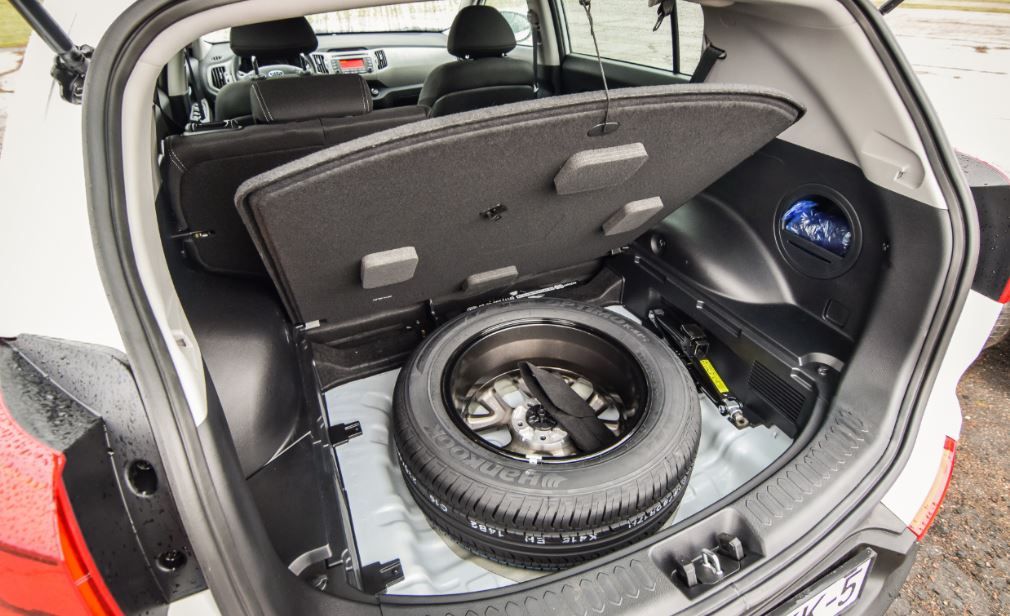 Zen
Zen
Tire pressure significantly affects driving parameters: comfort, car handling, economy and safety. It is important to maintain the pressure recommended by the manufacturer and check it regularly. Let's figure out how to do it right.
When driving on asphalt, incorrect tire pressure (both high and low) leads to a decrease in the contact patch with the road. An overinflated wheel clings to the surface only in the central part, which leads to its rapid wear. A poorly inflated tire, on the contrary, "sits" on the sidewalls, leaning on the shoulder areas of the tread and pushing the central part inward. Here's what it looks like:
Both under-inflation and over-inflation in tires create a lot of problems for the driver.
1. Increased wear of the central part of the tire tread.
2. Reduced ride comfort, hardness of potholes and road bumps.
Reduced ride comfort, hardness of potholes and road bumps.
3. Increased load on the car's suspension due to reduced tire damping effect.
4. Risk of tire damage and herniation due to shock loading (getting into a pit or pothole).
5. Reduced steering stability due to reduced contact patch.
1. Increased wear of the tread sidewalls (shoulder areas).
2. Severe deformation of the rubber when driving over bumps, which increases the risk of tire damage.
3. An increase in tire temperature, which threatens to delamination of the carcass and can lead to tire explosion at high speed.
4. Increased risk of hydroplaning on wet roads.
5. Risk of tire breaking.
6. Increased fuel consumption.
Reduced pressure hits the driver's pocket hard: a pressure drop of 20% (which is not uncommon: it is enough, for example, to deflate the wheels to 1.8 atmospheres instead of the manufacturer's prescribed 2.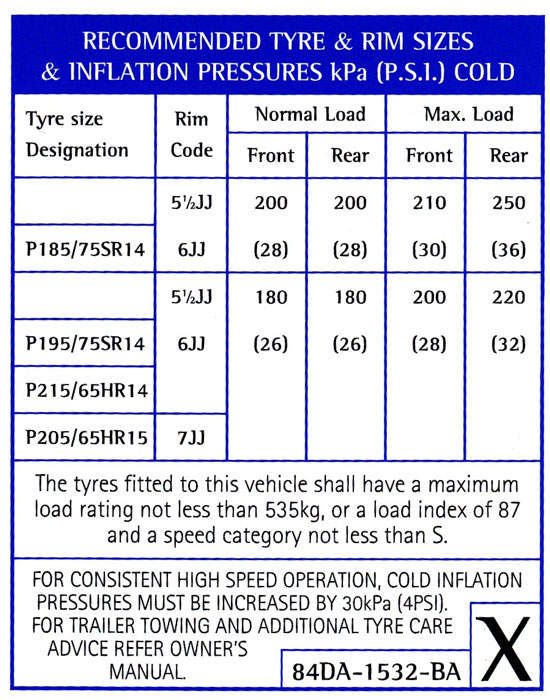 2) reduces tire life by 25-30% and increases fuel consumption fuel by 3%.
2) reduces tire life by 25-30% and increases fuel consumption fuel by 3%.
There is no universal tire pressure: it depends on the size of the tires, the characteristics of the car (primarily weight) and road conditions. Therefore, it is important to follow the factory recommendations, maintaining exactly the tire pressure that the engineers expected when designing the car.
The recommended pressure for your machine can be found in the instruction manual and on the sticker in the door frame. If, depending on the configuration, tires of several dimensions were installed on the car, then the pressure recommended for them may differ - look in the table for your exact wheel size. The manufacturer may prescribe an increase in tire pressure at the maximum load of the machine. For the spare tire (Spare tire), the required pressure is also indicated on a separate line - note that it is much higher than the standard one.
So, you have found the necessary pressure parameters, it remains to decipher them.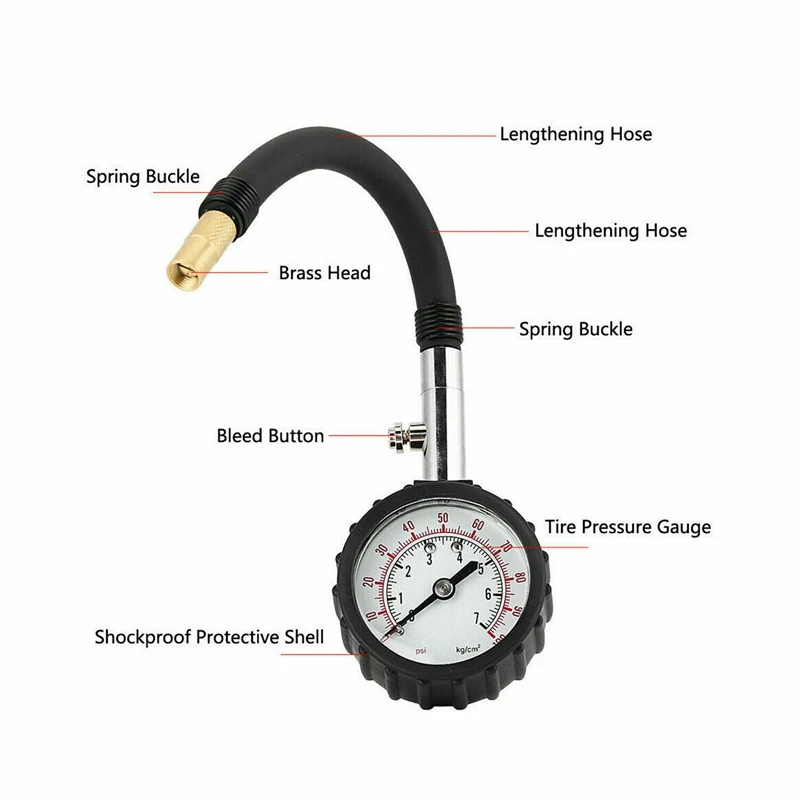 In physics, pressure is measured in pascals, in real life - in anything: in bars, atmospheres, pounds-force, kilogram-force ... Drivers and tire workers usually use the term atmosphere, but such a unit is often absent on pressure gauges (pressure measuring devices) . Let's clear up this confusion.
In physics, pressure is measured in pascals, in real life - in anything: in bars, atmospheres, pounds-force, kilogram-force ... Drivers and tire workers usually use the term atmosphere, but such a unit is often absent on pressure gauges (pressure measuring devices) . Let's clear up this confusion.
Atmosphere is a non-systemic unit of measurement, approximately equal to atmospheric pressure on the surface of the Earth. Since it has become widely used, it was necessary to somehow equate it with correct physical units. For simplicity, one atmosphere is considered equal to one bar, one kilogram-force and one hundred kilopascals.
In addition to the technical atmosphere (at), there is also the physical atmosphere (atm), which is slightly larger. Again, for convenience, they are considered equal. But all these assumptions introduce an error, so if you need accurate tire pressure, measure it correctly - in pascals or bars. Moreover, manufacturers usually indicate the pressure in these quantities.
Imperial pounds-force (aka PSI, “psy”), popular in the USA, is more difficult to translate, here you can’t do without a calculator. In the table, we have collected together all pressure units with exact values, and also approximately brought them to each other to simplify calculations:
| Pressure units | |||||
| Pascal | Bar | Technical atmosphere | Physical atmosphere | PSI | |
| 1 Pa | 1 N/m² | 10-5 | 10. | 9.8692•10-6 | 145.04•10-6 |
| 1 bar | 105 | 1x106 dynes/cm² | 1.0197 | 0.98692 | 14.504 |
| 1 at | 98066.5 | 0.980665 | 1 kgf/cm² | 0.96784 | 14.223 |
| 1 bar | 101325 | 1.01325 | 1.033 | 1 bar | 14. |
| 1psi | 6894.76 | 68.948•10-3 | 70.307•10-3 | 68.046•10-3 | 1lbf/in² |
It is advisable to check tire pressure daily, before driving. But this is only possible with a very measured rhythm of life. In reality, checking at least once a month is already an excellent indicator for the average driver. But before traveling a long distance, checking the pressure and visual inspection of tires and rims should be done in any case.
It is necessary to measure the pressure in cold tires, that is, before driving. During driving, the tires heat up, which increases the pressure by about 10%. Therefore, never release supposedly excess air from hot tires: after cooling, the pressure will be below normal.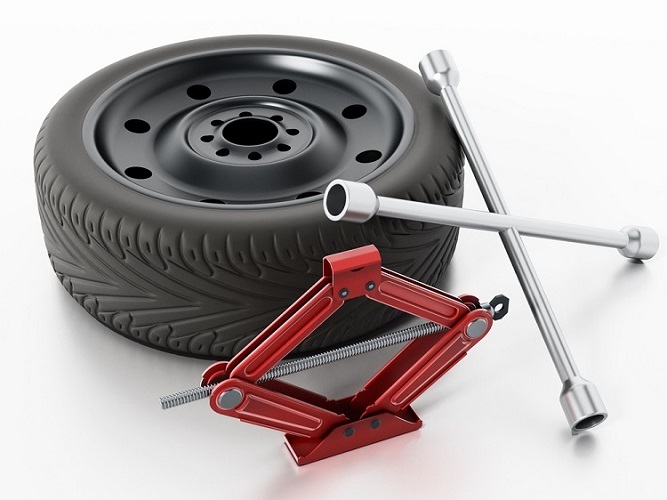 If you had to inflate a hot tire during a trip, inflate it 10% more than the nominal value, and check the pressure again when the wheels have cooled down - no earlier than 3 hours after stopping.
If you had to inflate a hot tire during a trip, inflate it 10% more than the nominal value, and check the pressure again when the wheels have cooled down - no earlier than 3 hours after stopping.
Always check the pressure in all tires. Different tire pressures seriously affect handling and can cause the car to pull to the side. Do not forget about the "spare tire": it should always be inflated in case of an unexpected wheel change on the road.
For long-term driving at high speeds (more than 160 km/h), car manufacturers advise increasing tire pressure by 0.2-0.4 bar from the recommended value. This will slightly improve the handling of the car, although it will negatively affect comfort. But such advice is relevant for driving on high-speed autobahns, and not for everyday urban use, especially in Russia.
Before a long trip on a dirt road or a road with a muddy surface (mud, snow), it is reasonable, on the contrary, to reduce the pressure in the tires - this will improve the grip. In summer, it is worth limiting yourself to reducing pressure by 5-10% of the nominal value, and in winter - by 10-15%.
In summer, it is worth limiting yourself to reducing pressure by 5-10% of the nominal value, and in winter - by 10-15%.
The pressure in low-profile tires (especially non-standard sizes) must be monitored especially carefully. Low profile tires have two features: a low sidewall (profile) height and a large rim diameter. If the tire has the correct air pressure, only the tread is in contact with the road. Low pressure causes the sidewall of the tire to bend, causing it to touch the roadway and wear out quickly, up to complete abrasion. And punching a low-profile tire in a pit at low pressure is much easier.
When inflating low profile tires, you need to focus on the pressure indicated for a full load of the machine and the maximum allowable pressure for a particular tire. It is indicated on the sidewall, next to the inscription max pressure, in one of the accepted units of measurement: kilopascals (KPA), bars (BAR) or pounds-force (PSI).